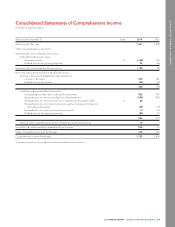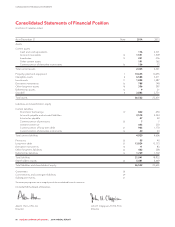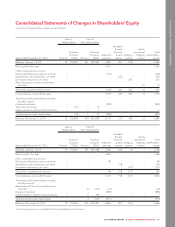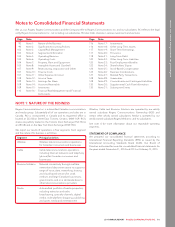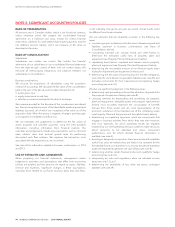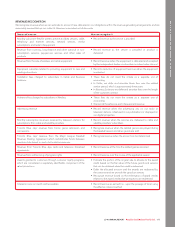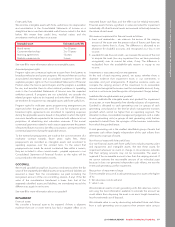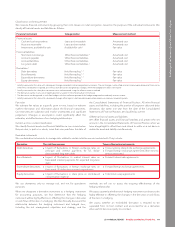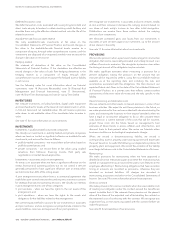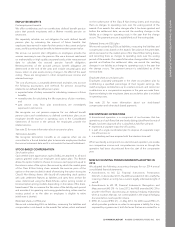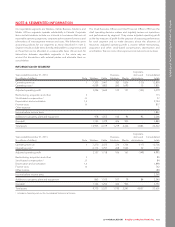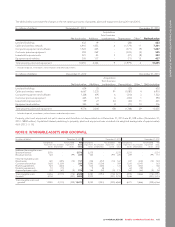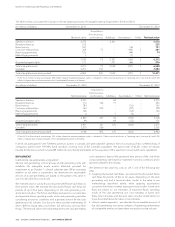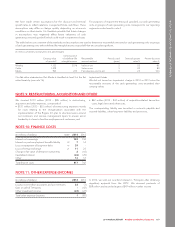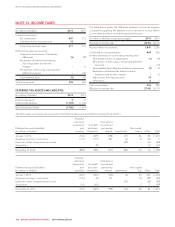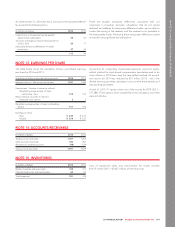Rogers 2014 Annual Report Download - page 103
Download and view the complete annual report
Please find page 103 of the 2014 Rogers annual report below. You can navigate through the pages in the report by either clicking on the pages listed below, or by using the keyword search tool below to find specific information within the annual report.
NOTES TO CONSOLIDATED FINANCIAL STATEMENTS
Classification and measurement
We measure financial instruments by grouping them into classes on initial recognition, based on the purpose of the individual instruments. We
classify all financial assets and liabilities as follows:
Financial instrument Categorization Measurement method
Financial assets
Cash and cash equivalents Loans and receivable Amortized cost
Accounts receivable Loans and receivable Amortized cost
Investments, available-for-sale Available-for-sale 1Fair value
Financial liabilities
Short-term borrowings Other financial liabilities 2Amortized cost
Accounts payable Other financial liabilities Amortized cost
Accrued liabilities Other financial liabilities Amortized cost
Long-term debt Other financial liabilities 2Amortized cost
Derivatives 3
Debt derivatives Held-for-trading 1, 4 Fair value
Bond forwards Held-for-trading 1, 4 Fair value
Expenditure derivatives Held-for-trading 1, 4 Fair value
Equity derivatives Held-for-trading 5Fair value
1Initially measured at fair value with subsequent changes recorded in other comprehensive income. The net change is reclassified into net income upon disposal of the asset or
when the asset becomes impaired, or in the case of derivatives designated as hedges, when the hedged item affects net income.
2Initially measured at fair value plus transaction costs and amortized using the effective interest method
3The derivatives can be in an asset or liability position at a point in time historically or in the future.
4The derivatives are designated as cash flow hedges with the ineffective portion of the hedge recognized immediately into net income
5Initially measured at fair value with subsequent changes offset against stock-based compensation expense or recovery in operating costs.
Fair value
We estimate fair values at a specific point in time, based on relevant
market information and information about the financial instruments.
Our estimates are subjective and involve uncertainties and significant
judgement. Changes in assumptions could significantly affect the
estimates, and effectiveness of our hedging relationships.
Current and non-current classification
We classify financial assets and financial liabilities as non-current when
they are due, in part or in whole, more than one year from the date of
the Consolidated Statements of Financial Position. All other financial
assets and liabilities, including the portion of long-term debt and debt
derivatives due within one year from the date of the Consolidated
Statements of Financial Position, are classified as current.
Offsetting financial assets and liabilities
We offset financial assets and financial liabilities and present the net
amount in the Consolidated Statements of Financial Position when we
have a legal right to offset them and intend to settle on a net basis or
realize the asset and liability simultaneously.
Derivative instruments
We use derivative instruments to manage risks related to certain activities we are involved with. They include:
Derivative The risk they manage Types of derivative instruments
Debt derivatives •Impact of fluctuations in foreign exchange rates on
principal and interest payments for US dollar-
denominated long-term debt
•Cross-currency interest rate exchange agreements
•Forward foreign exchange agreements (from time to
time as necessary)
Bond forwards •Impact of fluctuations in market interest rates on
forecasted interest payments for expected long-term
debt
•Forward interest rate agreements
Expenditure derivatives •Impact of fluctuations in foreign exchange rates on
forecasted US dollar-denominated expenditures
•Forward foreign exchange agreements
Equity derivatives •Impact of fluctuations in share price on stock-based
compensation expense
•Total return swap agreements
We use derivatives only to manage risk, and not for speculative
purposes.
When we designate a derivative instrument as a hedging instrument
for accounting purposes, we first determine that the hedging
instrument will be highly effective in offsetting the changes in fair value
or cash flows of the item it is hedging. We then formally document the
relationship between the hedging instrument and hedged item,
including the risk management objectives and strategy, and the
methods we will use to assess the ongoing effectiveness of the
hedging relationship.
We assess quarterly whether each hedging instrument continues to be
highly effective in offsetting the changes in the fair value or cash flows
oftheitemitishedging.
We assess whether an embedded derivative is required to be
separated from its host contract and accounted for as a derivative
when we first become a party to a contract.
2014 ANNUAL REPORT ROGERS COMMUNICATIONS INC. 99


